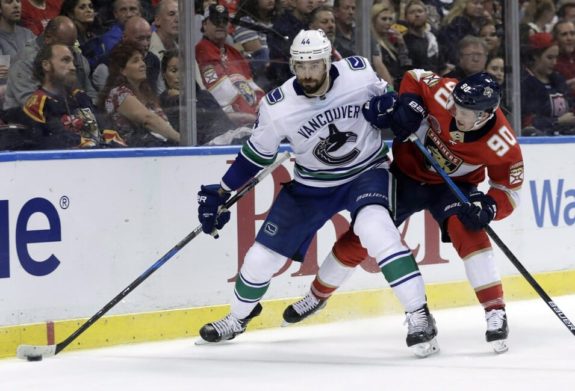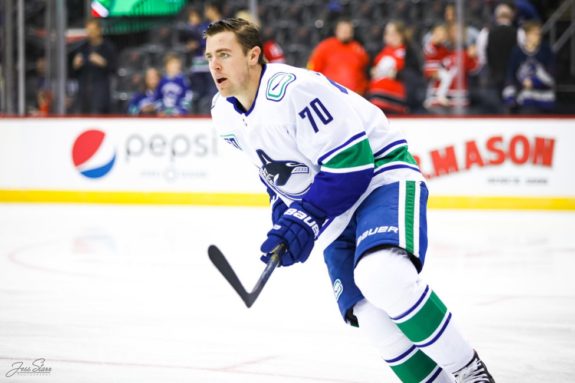A couple of days before the 2019 NHL Trade Deadline, Jim Benning, the general manager of the Vancouver Canucks, announced that the team had acquired winger Tanner Pearson for defenceman Erik Gudbranson.
Gudbranson had once been a top-three draft pick, yet his large, lumbering style had not worked out on a rebuilding Canucks team. Vancouver was Pearson’s third team of the season and the winger had only 15 points in the 61 games he had played that year. Obviously, Canucks management saw something the rest of us did not, as Pearson clicked upon arriving and has enjoyed the best hockey of his career so far in Vancouver.
Bringing Pearson to Vancouver
Gudbranson was often used as a whipping boy by Vancouver fans and media as his style of play, built upon his size and strength, harkened back to an older NHL. He routinely failed to keep up with the speed of the modern game and never recorded 10 points in a season during his time with the Canucks.

In fact, out of the eight defenceman that played at least 1,000 minutes for the Canucks from 2017 to 2019, Gudbranson ranked last in advanced stat categories such as Corsi For percentage (CF%), Fenwick For percentage (FF%), and High Danger Scoring Chance For percentage (HDCF%).
Related: The Sedin Twins and the 1999 NHL Draft
To be blunt, he was the Canucks’ worst defenceman as he failed to carry possession or contribute on either end of the ice in a significant manner. Pair these stats with the fact that he had a cap hit of $4 million, and it becomes clear why he was not the most popular player in Vancouver.
At the time of the trade, Pearson seemed to be on the downside of his career. He had put up 24 goals two seasons ago as part of “That 70s Line” in Los Angeles, but had scored only 15 the season after, and was in the middle of an abysmal season when Pittsburgh made the decision to ship him out.
One explanation for Pearson’s rough season may have had to do with his deployment. During his best season in LA, Pearson had a career-high offensive zone face-off percentage of 64.36 percent. In Pittsburgh, he was used differently, as he only started in the offensive zone 49.71 percent of the time.
Maybe it was something along these lines that persuaded Jim Benning and the Canucks to make the trade. The trade was made on Feb. 25 and it has turned out to be one of the most successful moves of the Benning era.
Pearson Find His Role in Vancouver
Pearson managed to finish the final 19 games of the 2018-19 season on the Canucks, his third team of the season, and looked like a new player. He scored 9 goals in the 19 games, matching his goal total in the other 61 games he had played that season. This created cautious optimism that Pearson could be a part of the Canucks’ long term plans.
He was offered a larger role in Vancouver and took advantage of it, however, his deployment has surprisingly become more defensive. His offensive zone faceoff percentage has never approached Pittsburgh or Los Angeles levels, yet he has found a way to score points at career-high levels.

This season, Pearson managed to set a new career-high in points while breaking the 20-goal plateau for the second time. Pearson was also reunited with an old linemate when the Canucks acquired Tyler Toffoli at this year’s trade deadline. The two never got the chance to play together for an extended period of time, though, as Toffoli took top-line duties while Brock Boeser was injured, but if the Canucks are able to re-sign Toffoli this offseason they may be able to recreate a pseudo “That 70s Line” with captain Bo Horvat taking Jeff Carter’s spot.
One of Jim Benning’s Best Moves
Benning has had his ups and downs during his time as GM of the Canucks, but the Pearson trade is one of his best moves. Pearson projects as a middle-six forward who can score and has seemingly developed some chemistry with Horvat. The Canucks have really solidified their scoring with the addition of Pearson, J.T. Miller, and Toffoli, and that is why they are one of the most improved offensive teams this season. Meanwhile, Gudbranson was traded to Anaheim where he has been slightly better than he was in Vancouver for the rebuilding Ducks.

With the Canucks looking to contend in the near future they must have scoring coming from multiple lines. The Pearson trade has given Horvat a winger that can score, freeing him from the rotation of mediocre players he had on his wing previously. If the Canucks are able to retain Toffoli for next season, they should boast a dangerous top six capable of keeping up with any forward group in the league and it was built off the back of trades like this one.